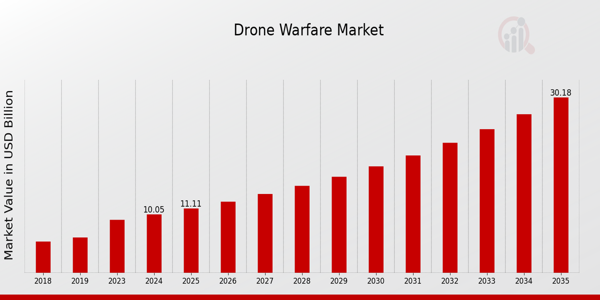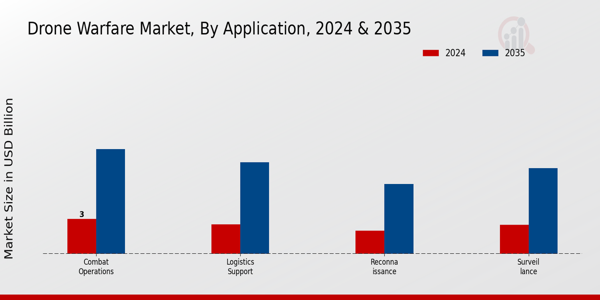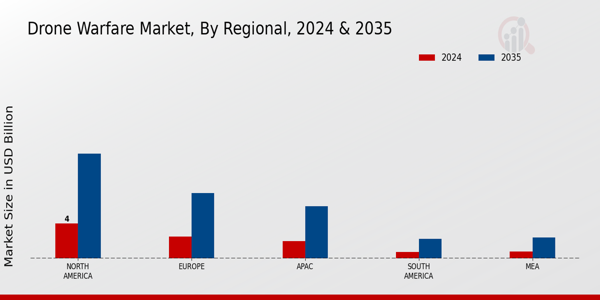Global Drone Warfare Market Overview
Drone Warfare Market Size was estimated at 9.1 (USD Billion) in 2023. The Drone Warfare Market Industry is expected to grow from 10.05(USD Billion) in 2024 to 30.2 (USD Billion) by 2035. The Drone Warfare Market CAGR (growth rate) is expected to be around 10.51% during the forecast period (2025 - 2035).

Source: Primary Research, Secondary Research, Market Research Future Database and Analyst Review
Key Drone Warfare Market Trends Highlighted
The Drone Warfare Market is experiencing significant growth driven by various factors, including technological advancements and increasing defense budgets in numerous countries. New developments in drone technology, particularly in artificial intelligence and automation, enhance the capabilities and efficiency of unmanned aerial vehicles (UAVs) . Nations are prioritizing the integration of drones into their military strategies for surveillance, reconnaissance, and combat missions, which signifies a shift in modern warfare tactics. Furthermore, geopolitical tensions and conflicts have led to an expanded focus on drone capabilities by governments ly, prompting investments in research and development.
The market offers considerable opportunities, particularly as nations acknowledge the strategic advantages that drones offer. There is a significant increase in demand for the enhancement of the operational capabilities of current drone fleets and the development of more advanced systems that incorporate swarm technology and advanced weapon systems. Furthermore, the development of drone warfare applications necessitates partnerships between the government and private sectors. Additionally, it is imperative to prioritize drone operator and ground control system training in order to optimize these sophisticated technologies.
The ethical implications and regulations of drone warfare have been the subject of increasing interest in recent years.
The deployment and use of drones are currently being evaluated by governments, with an emphasis on humanitarian considerations and compliance with international laws. This awareness creates opportunities for dialogue and collaboration between civilian and military stakeholders to establish frameworks for responsible drone use. The transition to systems that are more compact and readily deployable is also apparent, as it is designed to accommodate agile military operations that respond promptly to emerging threats.
Drone Warfare Market Drivers
Increasing Military Spending
The Drone Warfare Market Industry is significantly driven by the rising military expenditures across various countries. According to the Stockholm International Peace Research Institute, military spending has seen an uptick, reaching over 2 trillion USD in 2022, marking a 3.7% increase compared to the previous year. Countries such as the United States, China, and India are among the largest investors in defense technologies, further amplifying the demand for advanced military drones.
This increase in defense budgets is largely influenced by ongoing geopolitical tensions and the necessity for nations to modernize their armed forces. Consequently, militaries are increasingly investing in unmanned aerial vehicles (UAVs) for their strategic advantages, operational flexibility, and cost-effectiveness in safeguarding national security. With the focus on enhancing border security and counter-terrorism efforts, this trend is poised to significantly drive growth in the Drone Warfare Market Industry in the years to come.
Technological Advancements in Drone Technology
Rapid advancements in technology are a crucial driver of the Drone Warfare Market Industry. Innovations such as improved artificial intelligence algorithms, enhanced battery life, and more effective miniaturization techniques have enabled the creation of highly sophisticated drone systems. For instance, the incorporation of AI facilitates autonomous navigation and target recognition, thus enhancing operational efficiency. As reported by the National Aeronautics and Space Administration, advances in drone technology can lead to better mission outcomes with reduced risks for human personnel.
Additionally, established organizations like Boeing and Northrop Grumman are consistently investing in Research and Development to innovate drone capabilities, ensuring improved performance and safety in military operations. This relentless pursuit of technological excellence directly correlates with an increase in adoption rates of drone systems in military applications, significantly propelling the growth of the Drone Warfare Market Industry.
Rise in Asymmetric Warfare Tactics
The rise in asymmetric warfare tactics, where smaller, often unconventional forces use innovative strategies to combat larger militaries, has led to an increased demand for drone warfare capabilities within the Drone Warfare Market Industry. The prevalence of such tactics is evident in various conflict zones around the world, where non-state actors leverage drones for reconnaissance, surveillance, and strike missions. According to NATO reports, the utilization of drones has been instrumental in providing critical intelligence in combat operations, often improving mission success rates significantly.
This trend has pushed traditional armed forces to integrate drone technology into their arsenals, not only for offensive capabilities but also for defense and surveillance. The growing recognition of drone efficiency in asymmetric warfare strategies is expected to influence military planning, resulting in a higher allocation of resources toward advanced drone systems, thus driving further growth in the Drone Warfare Market Industry.
Drone Warfare Market Segment Insights
Drone Warfare Market Application Insights
The Drone Warfare Market, focused on application segments, presents significant insights into its dynamic landscape. By 2024, the market is expected to encompass a variety of applications, each serving distinct strategic roles. Surveillance applications are projected to hold a value of 2.5 USD Billion in 2024, with a robust increase to 7.35 USD Billion by 2035, illustrating their critical nature in intelligence gathering, threat assessment, and real-time monitoring. Combat Operations follow closely, valued at 3.0 USD Billion in 2024, with forecasts suggesting it will reach 9.0 USD Billion in 2035.
The growing complexities of modern warfare underscore the importance of combat-ready drones, enabling precision strikes and minimizing collateral damage. Furthermore, Reconnaissance is another essential application segment, valued at 2.0 USD Billion in 2024, growing to 6.0 USD Billion in 2035, demonstrating its vital role in mission planning and tactical superiority. Logistics Support holds a value of 2.55 USD Billion in 2024, expanding to 7.85 USD Billion by 2035, which showcases the growing recognition of drones in enhancing military supply chains, ensuring timely delivery of resources, and maintaining operational readiness.
The overall market dynamics indicate that within these applications, Surveillance and Combat Operations are likely to dominate due to their paramount importance in modern military strategy. This sector is driven by increasing defense budgets ly, technological advancements, and a rise in asymmetric warfare tactics. As nations invest in drone capabilities, the Drone Warfare Market revenue is poised for considerable growth, reflecting both current military needs and future potential.

Source: Primary Research, Secondary Research, Market Research Future Database and Analyst Review
Drone Warfare Market Type Insights
The Drone Warfare Market is poised for substantial growth, with an expected valuation of 10.05 USD Billion in 2024 and 30.2 USD Billion by 2035, demonstrating significant market potential. This market is largely segmented into various types, including Unmanned Aerial Vehicles, Combat Drones, Reconnaissance Drones, and Cargo Drones , each of which plays a crucial role in modern military strategies. Unmanned Aerial Vehicles are increasingly recognized for their versatility and effectiveness in reconnaissance and surveillance missions.
Combat Drones have become essential for precision targeting and minimizing collateral damage in conflict zones, while Reconnaissance Drones provide real-time intelligence, significantly enhancing situational awareness on the battlefield.
Meanwhile, Cargo Drones are emerging as vital logistics support, efficiently transporting supplies to remote and difficult-to-access areas. The Drone Warfare Market is witnessing key trends, such as advancements in artificial intelligence and automation, driving innovation in drone capabilities. As nations focus on strengthening their defense mechanisms, the demand for sophisticated drone technologies is growing, propelled by increased geopolitical tensions and the need for effective surveillance and strike options. Thus, this segment remains a critical area of development within the Drone Warfare Market.
Drone Warfare Market End Use Insights
The Drone Warfare Market showcases significant growth across various End Use categories, including Military, Government Agencies, and Private Contractors. By 2024, the market was expected to be valued at 10.05 billion USD, reflecting an increased reliance on unmanned aerial systems in military operations and surveillance. The military sector is a key driver for this market, as armed forces ly integrate drones for enhanced reconnaissance, precision strikes, and operational efficiency. Government Agencies utilize drones for diverse applications such as border surveillance, law enforcement, and disaster response, thereby playing a vital role in public safety and national security.
Private Contractors are also contributing to the market's expansion by providing innovative drone solutions and support services, adapting to rapidly changing technological demands. The increased focus on automation and unmanned systems across these segments represents a significant opportunity for growth within the Drone Warfare Market. Continued advancements in drone technology and data analytics are expected to further drive market development while challenges related to regulation and technology integration persist. Thus, the End Use segment remains a critical component in understanding overall market dynamics and trends within the Drone Warfare Market industry.
Drone Warfare Market Payload Capacity Insights
The Drone Warfare Market shows a significant focus on Payload Capacity, which is a key determinant in mission effectiveness and operational versatility. By 2024, the overall market is set to be valued at 10.05 USD Billion, highlighting the growing importance of technological advancements in drone capabilities. Within the payload capacity dimension, the market can be categorized into distinct segments: Low Payload, Medium Payload, and High Payload, each catering to specific operational needs. Low Payload drones are increasingly utilized for reconnaissance missions due to their lightweight and agile design, enabling quick deployments.
Medium Payload systems are gaining traction for tactical operations as they balance flight endurance and payload capacity, facilitating supply drop functions and surveillance tasks. High Payload drones dominate in strategic operations, often equipped to carry advanced weaponry or surveillance systems, thus playing a crucial role in modern warfare. The Drone Warfare Market revenue reflects ongoing investments in Research and Development, driven by the rising demand for efficient and effective aerial operations, while also navigating challenges such as regulatory compliance and technological advancements.
Each payload category represents a crucial component in fulfilling diverse military objectives, showcasing the industry's dynamic nature in adapting to emerging scenarios.
Drone Warfare Market Regional Insights
The Drone Warfare Market is witnessing significant growth across various regions, with a total market value expected to reach 10.05 USD Billion by 2024. North America exhibits a dominant position in this landscape, holding a majority share with a valuation of 4.0 USD Billion and projected to surge to 12.0 USD Billion by 2035, driven by advanced technological integration and increased defense spending. Europe follows as the second largest market, valued at 2.5 USD Billion in 2024 and aiming for 7.5 USD Billion by 2035, influenced by robust research initiatives and geopolitical tensions.
The Asia-Pacific (APAC) region is also gaining traction with a 2024 value of 2.0 USD Billion, anticipated to expand to 6.0 USD Billion, reflecting the rising investments in military capabilities and technological advancements in countries like China and India. South America and the Middle East and Africa (MEA) markets, valued at 0.75 USD Billion and 0.8 USD Billion respectively in 2024, highlight emerging opportunities, albeit having relatively smaller contributions. Increased defense budgets and the need for surveillance drive the demand within these regions, while challenges such as ethical considerations and regulatory constraints persist.
Overall, the regional segmentation of the Drone Warfare Market reveals varied growth trajectories and opportunities that stem from regional dynamics and strategic alliances.

Source: Primary Research, Secondary Research, Market Research Future Database and Analyst Review
Drone Warfare Market Key Players and Competitive Insights
The Drone Warfare Market has become a focal point within the defense sector, highlighting the increasing reliance on unmanned aerial vehicles (UAVs) for operational superiority. As nations continue to modernize their military capabilities, understanding the competitive dynamics of this market is essential. The proliferation of drone technology and its application in warfare has heightened competition among manufacturers and service providers. Companies are focusing on innovation, strategic partnerships, and advanced technologies to gain a competitive edge. With a variety of players entering the realm, the market is characterized by rapid advancements and shifting regulatory landscapes, leading to a complex competitive environment.
Textron's presence in the Drone Warfare Market is well-established, with a portfolio that emphasizes advanced UAV technology and a focus on enhancing situational awareness for military operations. The company leverages its longstanding expertise in aerospace and defense to develop cutting-edge drone systems capable of performing various missions, from surveillance to targeted strikes. Textron's strengths lie in its robust research and development capabilities, enabling the company to stay at the forefront of technological advancements in the drone sector.
The company has also been successful in forming partnerships and collaborations, allowing it to enhance its market offerings and respond swiftly to the evolving demands of clients ly.
Anduril Industries represents a dynamic force within the Drone Warfare Market, specializing in innovative defense technologies designed to improve operational efficiency and reduce risks for military and security forces. The company is known for its comprehensive suite of products and services, including autonomous drone systems and advanced surveillance solutions. Anduril's strengths include a pioneering approach to integrating artificial intelligence and advanced robotics into its systems, which enhances decision-making capabilities during missions. Moreover, through strategic mergers and acquisitions, Anduril has been able to expand its technological portfolio, solidifying its position in the market.
Its agility in responding to emerging threats and the ability to deliver tailored solutions for national defense further bolster its competitive advantage in the arena.
Key Companies in the Drone Warfare Market Include
Drone Warfare Market Industry Developments
The Drone Warfare Market has been experiencing significant developments recently, particularly among major players like Textron, Anduril Industries, BAE Systems, and Northrop Grumman. In October 2023, General Atomics announced advancements in unmanned aerial vehicle technology aimed at enhancing operational capabilities in combat scenarios. Moreover, Lockheed Martin has been focusing on integrating artificial intelligence to improve targeting efficiency within drone systems. In terms of mergers and acquisitions, in August 2023, Raytheon Technologies acquired a strategic stake in a startup specializing in drone technology to strengthen its portfolio.
The growth of the market has been further fueled by increased defense budgets ly, with countries aiming to bolster their aerial capabilities. Over the past few years, notable trends included Israel Aerospace Industries successfully launching a new drone system in January 2022 designed for intelligence and surveillance applications. The overall market valuation is anticipated to rise significantly as investments in Research and Development accelerate, thereby enhancing the capability, range, and effectiveness of drone warfare solutions. This proactive stance from key industry players is likely to reshape strategies and operations in military engagements worldwide.
Drone Warfare Market Segmentation Insights
Drone Warfare Market Application Outlook
Drone Warfare Market Type Outlook
Drone Warfare Market End Use Outlook
Drone Warfare Market Payload Capacity Outlook
Drone Warfare Market Regional Outlook
|
Report Attribute/Metric
|
Details
|
|
Market Size 2023
|
9.1(USD Billion)
|
|
Market Size 2024
|
10.05(USD Billion)
|
|
Market Size 2035
|
30.2(USD Billion)
|
|
Compound Annual Growth Rate (CAGR)
|
10.51% (2025 - 2035)
|
|
Report Coverage
|
Revenue Forecast, Competitive Landscape, Growth Factors, and Trends
|
|
Base Year
|
2024
|
|
Market Forecast Period
|
2025 - 2035
|
|
Historical Data
|
2019 - 2024
|
|
Market Forecast Units
|
USD Billion
|
|
Key Companies Profiled
|
Textron, Anduril Industries, BAE Systems, Airbus, Elbit Systems, SAIC, Northrop Grumman, General Atomics, Leonardo S.p.A., Israel Aerospace Industries, Lockheed Martin, Kratos Defense and Security Solutions, Drone Aviation Holding Corp, Raytheon Technologies, Thales Group
|
|
Segments Covered
|
Application, Type, End Use, Payload Capacity, Regional
|
|
Key Market Opportunities
|
Increased defense budgets, Advanced surveillance systems, AI integration for autonomy, Cybersecurity enhancements, Dual-use technology development
|
|
Key Market Dynamics
|
technological advancements, rising military budgets, growing asymmetric warfare, increased surveillance needs, regulatory challenges
|
|
Countries Covered
|
North America, Europe, APAC, South America, MEA
|
Frequently Asked Questions (FAQ):
The Drone Warfare Market is expected to be valued at 10.05 USD Billion in 2024.
By 2035, the Drone Warfare Market is projected to reach a value of 30.2 USD Billion.
The expected CAGR for the Drone Warfare Market from 2025 to 2035 is 10.51%.
In 2024, North America is anticipated to be the largest market for drone warfare, valued at 4.0 USD Billion.
The European drone warfare market is expected to be valued at 2.5 USD Billion in 2024.
The key applications include Surveillance, Combat Operations, Reconnaissance, and Logistics Support.
The Drone Warfare Market for Combat Operations is projected to be valued at 9.0 USD Billion by 2035.
Major players include Textron, Anduril Industries, BAE Systems, Airbus, and Northrop Grumman, among others.
The Logistics Support application segment is expected to reach a market value of 7.85 USD Billion by 2035.
By 2035, the APAC region is expected to see a market value of 6.0 USD Billion in the Drone Warfare Market.

















